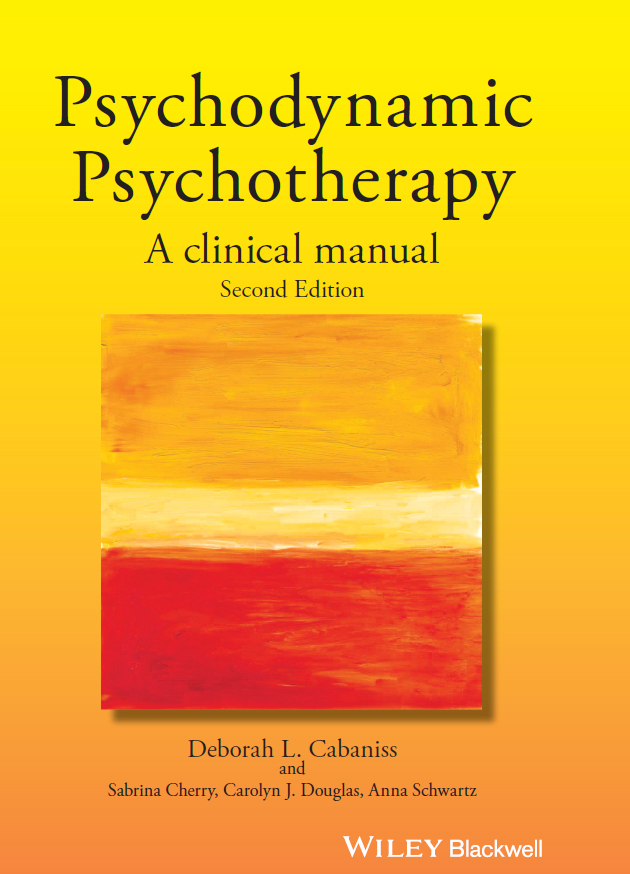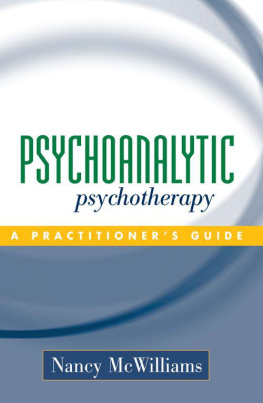Deborah L. Cabaniss - Psychodynamic Psychotherapy: A Clinical Manual
Here you can read online Deborah L. Cabaniss - Psychodynamic Psychotherapy: A Clinical Manual full text of the book (entire story) in english for free. Download pdf and epub, get meaning, cover and reviews about this ebook. year: 2016, publisher: Wiley, genre: Home and family. Description of the work, (preface) as well as reviews are available. Best literature library LitArk.com created for fans of good reading and offers a wide selection of genres:
Romance novel
Science fiction
Adventure
Detective
Science
History
Home and family
Prose
Art
Politics
Computer
Non-fiction
Religion
Business
Children
Humor
Choose a favorite category and find really read worthwhile books. Enjoy immersion in the world of imagination, feel the emotions of the characters or learn something new for yourself, make an fascinating discovery.

- Book:Psychodynamic Psychotherapy: A Clinical Manual
- Author:
- Publisher:Wiley
- Genre:
- Year:2016
- Rating:3 / 5
- Favourites:Add to favourites
- Your mark:
- 60
- 1
- 2
- 3
- 4
- 5
Psychodynamic Psychotherapy: A Clinical Manual: summary, description and annotation
We offer to read an annotation, description, summary or preface (depends on what the author of the book "Psychodynamic Psychotherapy: A Clinical Manual" wrote himself). If you haven't found the necessary information about the book — write in the comments, we will try to find it.
Psychodynamic Psychotherapy: A Clinical Manual — read online for free the complete book (whole text) full work
Below is the text of the book, divided by pages. System saving the place of the last page read, allows you to conveniently read the book "Psychodynamic Psychotherapy: A Clinical Manual" online for free, without having to search again every time where you left off. Put a bookmark, and you can go to the page where you finished reading at any time.
Font size:
Interval:
Bookmark:

This second edition first published 2017 2017 John Wiley & Sons, Ltd.
Edition history: John Wiley & Sons Ltd. (1e, 2011)
Registered Office John Wiley & Sons Ltd, The Atrium, Southern Gate, Chichester, West Sussex, PO19 8SQ, UK
| Editorial Offices | 350 Main Street, Malden, MA 02148-5020, USA |
| 9600 Garsington Road, Oxford, OX4 2DQ, UK | |
| The Atrium, Southern Gate, Chichester, West Sussex, PO19 8SQ, UK |
For details of our global editorial offices, for customer services, and for information about how to apply for permission to reuse the copyright material in this book please see our website at www.wiley.com/wiley-blackwell.
The right of Deborah L. Cabaniss, Sabrina Cherry, Carolyn J. Douglas, and Anna R. Schwartz to be identified as the authors of this work has been asserted in accordance with the UK Copyright, Designs and Patents Act 1988.
All rights reserved. No part of this publication may be reproduced, stored in a retrieval system, or transmitted, in any form or by any means, electronic, mechanical, photocopying, recording or otherwise, except as permitted by the UK Copyright, Designs and Patents Act 1988, without the prior permission of the publisher.
Wiley also publishes its books in a variety of electronic formats. Some content that appears in print may not be available in electronic books.
Designations used by companies to distinguish their products are often claimed as trademarks. All brand names and product names used in this book are trade names, service marks, trademarks or registered trademarks of their respective owners. The publisher is not associated with any product or vendor mentioned in this book.
Limit of Liability/Disclaimer of Warranty: While the publisher and authors have used their best efforts in preparing this book, they make no representations or warranties with respect to the accuracy or completeness of the contents of this book and specifically disclaim any implied warranties of merchantability or fitness for a particular purpose. It is sold on the understanding that the publisher is not engaged in rendering professional services and neither the publisher nor the author shall be liable for damages arising herefrom. If professional advice or other expert assistance is required, the services of a competent professional should be sought.
The contents of this work are intended to further general scientific research, understanding, and discussion only and are not intended and should not be relied upon as recommending or promoting a specific method, diagnosis, or treatment by physicians for any particular patient. The publisher and the author make no representations or warranties with respect to the accuracy or completeness of the contents of this work and specifically disclaim all warranties, including without limitation any implied warranties of fitness for a particular purpose. In view of ongoing research, equipment modifications, changes in governmental regulations, and the constant flow of information relating to the use of medicines, equipment, and devices, the reader is urged to review and evaluate the information provided in the package insert or instructions for each medicine, equipment, or device for, among other things, any changes in the instructions or indication of usage and for added warnings and precautions. Readers should consult with a specialist where appropriate. The fact that an organization or Website is referred to in this work as a citation and/or a potential source of further information does not mean that the author or the publisher endorses the information the organization or Website may provide or recommendations it may make. Further, readers should be aware that Internet Websites listed in this work may have changed or disappeared between when this work was written and when it is read. No warranty may be created or extended by any promotional statements for this work. Neither the publisher nor the author shall be liable for any damages arising herefrom.
Library of Congress Cataloging-in-Publication Data
Names: Cabaniss, Deborah L., author. | Cherry, Sabrina, author. | Douglas, Carolyn J., author. | Schwartz, Anna R., author.
Title: Psychodynamic psychotherapy : a clinical manual / Deborah L. Cabaniss and Sabrina Cherry, Carolyn J. Douglas, Anna Schwartz.
Description: Second edition. | Chichester, West Sussex ; Malden, MA : John Wiley & Sons Inc., [2017] | Preceded by Psychodynamic psychotherapy : a clinical manual / by Deborah L. Cabaniss ... [et al.]. 2011. | Includes bibliographical references and index.
Identifiers: LCCN 2016018489| ISBN 9781119141983 (cloth) | ISBN 9781119141990 (epub)
Subjects: | MESH: Psychotherapy, Psychodynamicmethods
Classification: LCC RC480 | NLM WM420.5.P75 | DDC 616.89/14dc23 LC record available at https://lccn.loc.gov/2016018489
A catalogue record for this book is available from the British Library.
For our families
Thomas, William and Daniel
Marc, Rebecca and Ruth
Jon, William and Ben
Eric, Lena and Maia
In the four years since Psychodynamic Psychotherapy: A Clinical Manual was published, we have taken to heart the enormous amount we have learned about it from our students and readers. While the core of our Listen/Reflect/Intervene method is largely unchanged, we have worked hard in writing this second edition to produce a manual that truly brings this treatment into the 21st century. Here are the highlights of what's new:
- Common factors: Outcome studies indicate that common factors, such as rapport with the therapist and expecting positive results, account for at least some of the efficacy of all talk therapies. This is true of psychodynamic psychotherapy as well. In this edition, the role of common factors is featured as a major theory of therapeutic action, and common factors are highlighted throughout.
- Modern language: Using terms like ego function and super-ego suggested that ego psychology was still the dominant way to think about psychodynamics. In this edition, we introduce new language for a new era. The idea of domains of function self, relationships, adapting, cognition, work/play echoes current constructions such as the NIMH's Research Domain Criteria (RDoCs). Even the ominous word termination is gone.
- Current research: This manual includes up-to-date research from epigenetics to outcome studies that impacts the way we think about psychodynamic psychotherapy today.
- Formulation: We have brought our ideas about formulation from our 2013 book Psychodynamic Formulation (Wiley 2013) into this edition, including the Describe/Review/Link method for teaching and constructing formulations.
- New concepts: Important current concepts and techniques, from mentalization to transference-focused treatment, are included. We have also updated our approach to resistance, defenses, and dreams.
- Use of this manual: Today, it is critical for both students and educators to have a guide for how to use manuals in conducting and teaching psychotherapy. Our new Use of this Manual section is designed to do just that.
- Educators' guide: We have included an Educators' Guide in this edition, much like the one in Psychodynamic Formulation, to help educators use this manual to anchor a psychodynamic curriculum. There are also more Suggested Activities to use in class, as well as evaluation tools.
- Psychoeducational material for patients: Lastly, we have included the Post-Evaluation Psychodynamic Psychotherapy Educational Resource the PEPPER to help you help your patients learn about this important treatment.
Font size:
Interval:
Bookmark:
Similar books «Psychodynamic Psychotherapy: A Clinical Manual»
Look at similar books to Psychodynamic Psychotherapy: A Clinical Manual. We have selected literature similar in name and meaning in the hope of providing readers with more options to find new, interesting, not yet read works.
Discussion, reviews of the book Psychodynamic Psychotherapy: A Clinical Manual and just readers' own opinions. Leave your comments, write what you think about the work, its meaning or the main characters. Specify what exactly you liked and what you didn't like, and why you think so.







